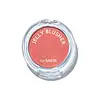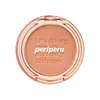What's inside
What's inside
 Key Ingredients
Key Ingredients

 Benefits
Benefits

 Concerns
Concerns

 Ingredients Side-by-side
Ingredients Side-by-side

Polymethyl Methacrylate
CI 77891
Cosmetic ColorantMica
Cosmetic ColorantDimethicone/Vinyl Dimethicone Crosspolymer
Skin ConditioningDimethicone
EmollientDiphenylsiloxy Phenyl Trimethicone
Skin ConditioningHydrogenated Poly(C6-14 Olefin)
EmollientPhenyl Trimethicone
Skin ConditioningDiisostearyl Malate
EmollientSilica
AbrasiveCI 19140
Cosmetic ColorantCI 15985
Cosmetic ColorantAluminum Hydroxide
EmollientPolymethylsilsesquioxane
CI 73360
Cosmetic ColorantCaprylyl Glycol
EmollientGlyceryl Caprylate
EmollientCI 77491
Cosmetic ColorantTriethoxycaprylylsilane
Lauroyl Lysine
Skin ConditioningTocopherol
AntioxidantPolymethyl Methacrylate, CI 77891, Mica, Dimethicone/Vinyl Dimethicone Crosspolymer, Dimethicone, Diphenylsiloxy Phenyl Trimethicone, Hydrogenated Poly(C6-14 Olefin), Phenyl Trimethicone, Diisostearyl Malate, Silica, CI 19140, CI 15985, Aluminum Hydroxide, Polymethylsilsesquioxane, CI 73360, Caprylyl Glycol, Glyceryl Caprylate, CI 77491, Triethoxycaprylylsilane, Lauroyl Lysine, Tocopherol
Talc
AbrasiveMica
Cosmetic ColorantMethyl Methacrylate Crosspolymer
Diisostearyl Malate
EmollientOctyldodecyl Stearoyl Stearate
EmollientVegetable Oil
Skin ConditioningDimethicone
EmollientMagnesium Myristate
Isocetyl Myristate
EmollientHydrogenated Lecithin
EmulsifyingAluminum Hydroxide
EmollientTitanium Dioxide
Cosmetic Colorant1,2-Hexanediol
Skin ConditioningGlyceryl Caprylate
EmollientMethicone
EmollientHelichrysum Italicum Flower Water
Skin ConditioningCI 19140
Cosmetic ColorantCI 77742
Cosmetic ColorantCI 73360
Cosmetic ColorantCI 77499
Cosmetic ColorantCI 77007
Cosmetic ColorantTalc, Mica, Methyl Methacrylate Crosspolymer, Diisostearyl Malate, Octyldodecyl Stearoyl Stearate, Vegetable Oil, Dimethicone, Magnesium Myristate, Isocetyl Myristate, Hydrogenated Lecithin, Aluminum Hydroxide, Titanium Dioxide, 1,2-Hexanediol, Glyceryl Caprylate, Methicone, Helichrysum Italicum Flower Water, CI 19140, CI 77742, CI 73360, CI 77499, CI 77007
 Reviews
Reviews

Ingredients Explained
These ingredients are found in both products.
Ingredients higher up in an ingredient list are typically present in a larger amount.
Aluminum Hydroxide is a form of aluminum. It can be naturally found in nature as the mineral gibbsite. In cosmetics, Aluminum Hydroxide is used as a colorant, pH adjuster, and absorbent.
As a colorant, Aluminum Hydroxide may add opacity, or reduce the transparency. Aluminum hydroxide is contains both basic and acidic properties.
According to manufacturers, this ingredient is an emollient and humectant. This means it helps hydrate the skin.
In medicine, this ingredient is used to help relieve heartburn and help heal ulcers.
There is currently no credible scientific evidence linking aluminum hydroxide in cosmetics to increased cancer risk.
Major health organizations allow the use of aluminum hydroxide in personal care products and have not flagged it as a carcinogenic risk at typical usage levels.
Learn more about Aluminum HydroxideCI 19140 is also known as Tartrazine. Tartrazine is a synthetic dye used in cosmetics, foods, and medicine to add a yellow color.
Tartrazine is created from petroleum and is water-soluble.
Some people may experience allergies from this dye, especially asthmatics and those with an aspirin intolerance.
Learn more about CI 19140Ci 73360 is a synthetic red-pink dye.
Diisostearyl Malate is an emollient and most often used in lip products. It comes from isostearyl alcohol, a fatty acid, and malic acid, an AHA.
As an emollient, Diisostearyl Malate helps create a thin film on your skin to trap moisture in. This helps keep your skin soft and smooth.
Dimethicone is a type of synthetic silicone created from natural materials such as quartz.
What it does:
Dimethicone comes in different viscosities:
Depending on the viscosity, dimethicone has different properties.
Ingredients lists don't always show which type is used, so we recommend reaching out to the brand if you have questions about the viscosity.
This ingredient is unlikely to cause irritation because it does not get absorbed into skin. However, people with silicone allergies should be careful about using this ingredient.
Note: Dimethicone may contribute to pilling. This is because it is not oil or water soluble, so pilling may occur when layered with products. When mixed with heavy oils in a formula, the outcome is also quite greasy.
Learn more about DimethiconeGlyceryl Caprylate comes from glycerin and caprylic acid, a fatty acid from coconut. It has emollient and emulsifier properties.
As an emollient, it helps hydrate your skin. Emollients work by creating a barrier on your skin to trap moisture in, helping to keep your skin soft and smooth.
On the other hand, emulsifiers prevent ingredients (such as oil and water) from separating.
Learn more about Glyceryl CaprylateMica is a naturally occurring mineral used to add shimmer and color in cosmetics. It can also help improve the texture of a product or give it an opaque, white/silver color.
Serecite is the name for very fine but ragged grains of mica.
This ingredient is often coated with metal oxides like titanium dioxide. Trace amounts of heavy metals may be found in mica, but these metals are not harmful in our personal products.
Mica has been used since prehistoric times throughout the world. Ancient Egyptian, Indian, Greek, Roman, Aztec, and Chinese civilizations have used mica.
Learn more about Mica